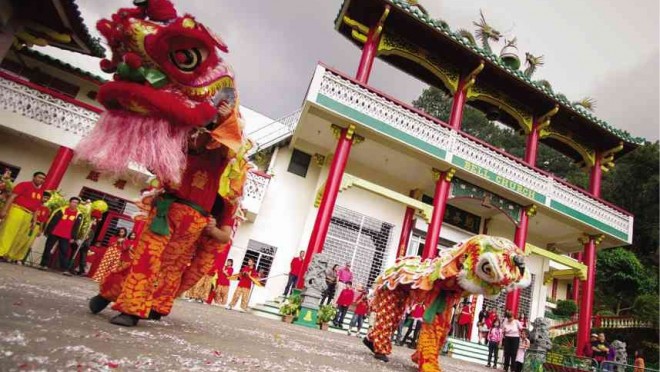
DANCERS perform at the Bell Church during the celebration of Chinese New Year in 2012. The church plays an important role in the spiritual and cultural life of the Chinese-Filipino community in Baguio City and Benguet province. RICHARD BALONGLONG
Atop a hill in the boundary of Baguio City and the vegetable-producing town of La Trinidad in Benguet province rests a patch of bamboo, whose leaves sway to the northern direction of the main entrance of the Bell Church, a Chinese temple that has drawn tourists to the summer capital.
On Jan. 24, Buddhists and Christians flocked to the Bell Church for the “poh toh,” a festival of spirits covering eight days of prayers and offerings to ask the heavens to accept wandering spirits in paradise.
Milan Quirino, a church member and owner of the defunct Chinese restaurant Sunshine Lunch in Baguio, says the bamboo serves as the spirits’ entrance. The spirits are then guided toward the temple and an octagon prayer table surrounded by living members of the family who pray that the spirits go to heaven.
The prayers “travel” through a chord that connects the table and a lantern hanging from the ceiling, eventually leading the spirits to heaven, Quirino says.
The poh toh is one of the spiritual festivals that is being observed at the Bell Church.
“During early times, the bell was used to call the attention of the people to spread messages and warn them of calamities and impending danger. We have carried that tradition. But this time, the bell is used as a tool for spiritual awakening,” says Rev. Elias Ng, a church leader.
Original site
The Bell Church was founded by Ng’s father, Ng Pee (Kok Fan), a Chinese immigrant. In 1954, Ng Pee used a dining hall of a restaurant to preach, but due to the limited space and the growing number of devotees, the place of worship had to be transferred to their house on Km 6 in La Trinidad.
The house in La Trinidad became the first site of the Bell Church.
“The members then were composed mostly of Chinese farmers. The membership grew fast and it came to a point that our house could not accommodate the people anymore. Back then, it was called the Chinese Buddhist Temple. It was changed to Bell Church when it transferred on Kilometer 3 in the 1960s,” Ng says.
The hilly landscape of the one-hectare property, says Ng, is a perfect location for the Bell Church since it has reminded the Chinese churchgoers of their hometowns in Hong Kong or mainland China.
Support from the local Chinese community poured in and the solitary house that served as church has been turned into a temple, Ng says.
“We turned to the guidance of the saints to ask them how they want the place to be designed. From the exterior to the interior, all of these were orders from the saints,” Ng says.
Dr. Manuel Quirino, Bell Church president and husband of Milan, says Ng is the church’s spiritual medium. “He can read the words of the saints by spreading [a type of] powder on glass…. There were people who would ask the questions and Reverend Elias would write the answer relayed by the saints,” Dr. Quirino says.
Ng says the design of the Bell Church drastically improved on orders of the saints. Visitors are welcomed by an arch adorned with colorful figures of dragons and Chinese inscriptions that would lead them to main entrance of the temple where the bell hangs.
The imposing structure faces several pagodas where images of saints and the Buddha are displayed. The bust of Ng Pee occupies an important place in the compound.
Fronting the temple are two octagon ponds adorned with floating lotuses. The octagon (bagua) in Chinese culture symbolizes rebirth and infinity, while the lotus flowers symbolize beauty and purity, church leaders say.
“This place was muddy before it became what it is now. The Chinese gardeners helped landscape and improve the place. The church was built here because of the good feng shui,” Milan says.
She is referring to Bell Church’s five patron saints who represent Taoism, Confucianism, Islam, Christianity and Buddhism.
Ng says churchgoers have been sharing testimonies of answered prayers and miracles that helped deepen their spirituality.
In their 1997 book, “The Ethnic Chinese in Baguio and the Cordillera Philippines,” the late Dr. Charles Cheng and Katherine Bersamira-Cheng cited the importance of the Bell Church in the local community.
“Aside from being a place of worship, many Chinese and even Filipinos who believe in the power of the oracle go there to seek answers to their questions about the future, when to start a business, which type of business, when to set the date of marriage, when to build and many more,” they said.
Tourist magnet
But the church, apart from serving the spiritual needs of its members, serves as a tourist magnet for Baguio and La Trinidad.
Ng says former Tourism Minister Jose Aspiras, in 1970, recognized the Bell Church as a major tourist destination.
“It was even popular for filmmakers. A lot of films had been shot here from the 1970s and to the 1990s because the area looked like a place in Hong Kong or Singapore. There were so many local kung fu films that had been shot here, even romantic movies that wanted to project that the characters went to Hong Kong for their honeymoon,” Ng says.
Aside from being a place of worship and meditation, the church is an important a venue for cultural festivals of the local Chinese-Filipino community.
Dr. Quirino says apart from Chinese New Year, they celebrate Christmas Day and Valentine’s Day here.
The church has a gym where instructors give lessons on martial arts, and dragon and lion dance performances.
Its leaders say the Bell Church promotes peace, unity and spiritual healing.